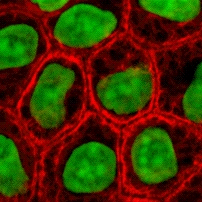Арсланова_Г_А_и_др_Essential_English_for_Biology_Students (1). Kazan federal university
 Скачать 7.01 Mb. Скачать 7.01 Mb.
|
Unit II. СELL3 Text 2.1 Cell Theory ■ Essential targets By the end of this text you should be able to: ● describe the main ideas of the cell theory ● compare the structures of animal and plant cells as seen with a light microscope. Pre-reading ■ With a partner consider the following questions and try to answer them. Then quickly scan the text to check your answers. What is a cell? Who discovered cells? Do plant cells differ from animal cells? ■ Read the given text and make your essential assignments: Cells were discovered in 1665 by the English scientist and inventor Robert Hooke. Hooke designed his own compound light microscope to observe structures too small to be seen with the naked eye. Among the first structures he examined was a thin piece of cork (the outer surface of bark from a tree). Hooke described the cork as being made of hundreds of little boxes, giving it the appearance of a honeycomb. He called these little boxes cells. It soon became clear that virtually all living things are made of cells, and that these cells have certain features in common. The cell theory The concept that cells are the basic units of life became embodied in a theory called the cell theory, which embraces the following main ideas: cells form the building blocks of living organisms cells arise only by the division of existing cells cells contain inherited information which controls their activities the cell is the functioning unit of life; metabolism (the chemical reactions of life) takes place in cells given suitable conditions, cells are capable of independent existence. A typical animal cell The structure of a typical animal cell: the cell has a cell surface membrane which encloses the cell contents the contents consist of a central ball-shaped nucleus surrounded by material called cytoplasm the nucleus contains a fibrous material called chromatin this condenses to form chromosomes during cell division chromatin contains DNA, the material which controls the various activities inside the cell scattered within the cytoplasm are mitochondria, small rod-like structures. They have been described as the “power-houses” of the cell because they supply energy. smaller dots within the cytoplasm are particles of stored food. Many consist of glycogen, which is a food storage polysaccharide. A typical plant cell Like an animal cell, a typical plant cell has a cell surface membrane, cytoplasm, and a nucleus. However, plant cells differ from animal cells in several ways: most plant cells have a large sap-filled cavity called the vacuole. Sap is a watery fluid containing salts and sugars. The vacuole surrounded by a membrane called the tonoplast. the cytoplasm contains starch grains, the food storage products of plants many plant cells have chloroplasts in the cytoplasm. These contain the pigments used in photosynthesis. Chlorophyll, which is green, is the main pigment. Chloroplasts occur only in the parts of plants exposed to light – the green parts. They are absent from underground structures such as roots. ■ Glossary of essential terms for you to know
■ Your Essential Assignments I. Quick check 1. Briefly state the main concept of the cell theory. 2. List the features: a) that only animal cells have b) that only plant cells have c) that both animal and plant cells have. II. Fill in the missing words:
III. Use monolingual English dictionary and write down what could the words given below mean: surface, honeycomb, cavity, plant, sap. IV. Match these words with their definitions:
V. Find English equivalents to the following word combinations:
VI. GiveRussianequivalents to the following English terms:
VII. Find synonyms among the pool of words:
VIII. Answer the following questions. Use all information given before: When were cells discovered? How did Robert Hooke discover cells? What is called the cell theory? What are the main ideas of the cell theory? What is the structure of a typical animal cell? How do plant cells differ from animal cells? IX. Match the sentence halves. Make complete sentences:
X. Read and translate the short text without any dictionary: Fact of life: Robert Hooke described his observations of the cork cells: “I counted several lines of these pores, and found that there were usually about three-score of these small Cells placed end-ways in the eighteenth part of an inch in length, whence I concluded that there must be near eleven hundred of them, or somewhat more than a thousand in length of an inch and therefore in a square inch above a Million, or 1 166 400, and in a Cubick Inch, above twelve hundred million, or 1 259 712 000, a thing almost incredible, did not our Microscope assure us of it by ocular demonstration. XI. Food for thought: Suggest why red blood cells appear to contradict the cell theory. |
